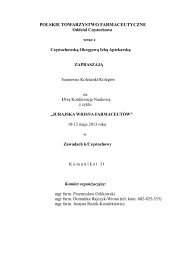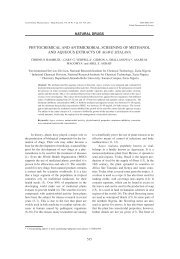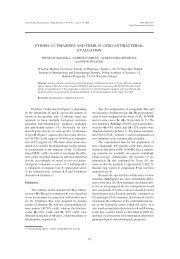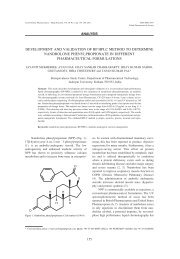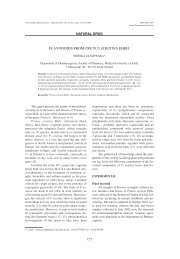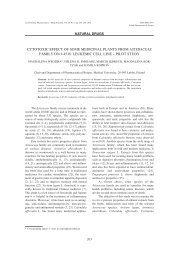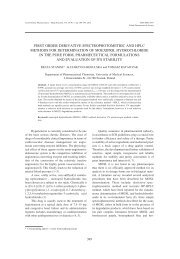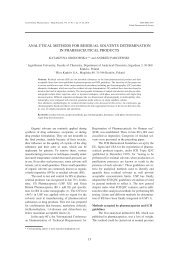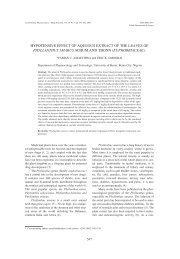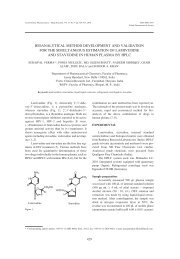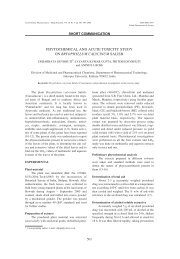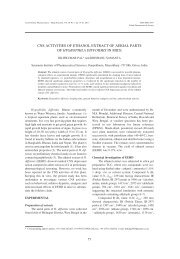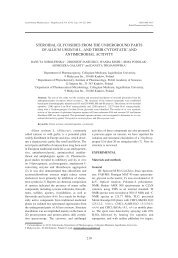KINETICS OF OMEPRAZOLE DEGRADATION IN SOLID STATE
KINETICS OF OMEPRAZOLE DEGRADATION IN SOLID STATE
KINETICS OF OMEPRAZOLE DEGRADATION IN SOLID STATE
You also want an ePaper? Increase the reach of your titles
YUMPU automatically turns print PDFs into web optimized ePapers that Google loves.
Acta Poloniae Pharmaceutica ñ Drug Research, Vol. 68 No. 5 pp. 753ñ757, 2011 ISSN 0001-6837<br />
Polish Pharmaceutical Society<br />
<strong>K<strong>IN</strong>ETICS</strong> <strong>OF</strong> <strong>OMEPRAZOLE</strong> <strong>DEGRADATION</strong> <strong>IN</strong> <strong>SOLID</strong> <strong>STATE</strong><br />
MARIA POPIELARZ-BRZEZI—SKA<br />
Department of Pharmaceutical Chemistry, Faculty of Pharmacy, Poznan University of Medical Sciences,<br />
Grunwaldzka 6, 60-780 PoznaÒ, Poland<br />
Abstract: The influence of temperature and relative air humidity on the stability of omeprazole (OME) in solid<br />
state was studied. Changes in the concentration were monitored by HPLC with UV detection. The method was<br />
validated; its selectivity, range of linearity, precision, limit of detection (LOD) and limit of quantification<br />
(LOQ) were established. The linearity was satisfactory (r = 0.9998) in the concentration range from 0.5 to 14.0<br />
mg/mL for a LiChrospher Æ 100 RP-18 column (5 µm particle size, 100 mm × 4 mm, Merck, Darmstadt,<br />
Germany) and the mobile phase of methanol : 100 mM ammonium acetate (60:40 v/v). Degradation was conducted<br />
in solid phase at increased temperature (313 K to 393 K) and in the air humidity varying from 25% to<br />
90% RH. The kinetic and thermodynamic parameters of OME decomposition in solid phase were determined.<br />
Keywords: omeprazole, HPLC, stability, solid state<br />
Omeprazole (OME) belongs to the medical<br />
drugs inhibiting the proton pump (H + /K -ATP-ase<br />
inhibitors), applied in therapy of peptic stomach or<br />
duodenal ulcer, Zollinger-Ellison syndrome, stomach-esophagus<br />
reflux and eradication of<br />
Helicobacter pylori. This drug is a bioprecursor that<br />
is activated in strongly acidic environment. The<br />
active metabolite ñ sulfenamide ñ reacts with<br />
sulfhydryl H + /K + groups of ATP-ase forming disufide<br />
bridges and irreversibly blocking the enzyme.<br />
The drug is mainly metabolized in the liver. OME is<br />
fully metabolized by the P450 cytochrome system<br />
(CYP) (1ñ3).<br />
In the analysis of inhibitor proton pump (IPP),<br />
the following methods: HPLC (4ñ7), UV-VIS (8),<br />
polarography (9) and TLC (10) were used. The<br />
study mainly focused in the determination of OME<br />
in body fluids. The literature does not refer to<br />
research into kinetics of OME for the substance in<br />
solid state.The study was undertaken to evaluate the<br />
stability of OME in the solid phase and establish the<br />
effect of temperature and relative air humidity on<br />
the process of OME degradation.<br />
EXPERIMENTAL<br />
Materials<br />
Omeprazole (5-methoxy-2-{[(4-methoxy-3,5-<br />
dimethyl-2-pyridinyl)methyl]sulfinyl}-1H-benzimidazole),<br />
lot no. 111K1500; content of the active substance<br />
99,8%; Sigma-Aldrich Chemie GmbH, Germany.<br />
Flutamide, Sigma-Aldrich Chemie GmbH,<br />
Germany, was used as an internal standard (IS).<br />
Ammonium acetate was from POCh Gliwice and all<br />
other chemicals were obtained from Merck KGaA<br />
(Germany) and were of analytical or high-performance<br />
liquid chromatographic grade.<br />
Equipment<br />
Chromatographic separation and quantitative<br />
determination of omeprazole were performed by<br />
using a high-performance liquid chromatograph<br />
equipped with a UV detector. The analytical system<br />
consisted of a Rheodyne 7120 injector with a 20 µL<br />
loop. As the stationary phase a LiChrospher Æ 100<br />
RP-18 column, 5 µm particle size 100 mm × 4 mm<br />
(Merck, Darmstadt, Germany) was used. The UV<br />
detection was performed at 302 nm (Pye Unicam,<br />
England). A pump (Merck-Hitachi, Germany) and<br />
A/C transmitter with the software Chromed<br />
(Medson, Poland). The mobile phase consisted of<br />
methanol : 100 mM ammonium acetate (60:40, v/v).<br />
The flow rate was 1.0 mL/min.<br />
Method validation<br />
The method was validated according to the<br />
Guidelines of the International Conference on<br />
Harmonization (11).<br />
* Corresponding author: e-mail: mpopiel@ump.edu.pl<br />
753
754 MARIA POPIELARZ-BRZEZI—SKA<br />
Selectivity<br />
Selectivity of the HPLC method was evaluated<br />
on the basis of measurements for the OME sample<br />
undegraded and two samples subjected to degradation<br />
at 373 K for 24 h and at 333 K and 76% relative<br />
air humidity for 24 h.<br />
Linearity<br />
The calibration curve of P OME /P IS = f(c) was<br />
drawn for OME concentrations in the range 0.5◊10 -2<br />
ñ14.0◊10 -2 mg/mL<br />
Precision<br />
Precision of the method was determined for<br />
three concentrations of OME: 0.400, 0.200 and<br />
0.100 mg/mL. The measurements were made on<br />
three subsequent days.<br />
Limit of detection and limit of quantification<br />
The LOD and LOQ values were calculated<br />
from the regression equation P OME /P IS = f(c), where<br />
LOD = 3.3 S y /a and LOQ = 10S y /a. S y and a values<br />
are the standard deviation and the slope, respectively,<br />
of the calibration curve.<br />
Kinetic studies<br />
Kinetic studies were performed at temperatures<br />
varied from 313 K to 393 K and at the relative<br />
air humidity varied from 25% to 90% in the thermal<br />
chambers. The exactly weighted samples (1 mg of<br />
Figure 1. HPLC chromatograms for an authentic sample of omeprazole (OME), its three degradation products and the internal standard<br />
(flutamide, IS), maintained at 393 K in dry air for 24 h, where h is the height and t is the retention time of a peak<br />
Figure 2. Semilogarithmic plots for degradation of OME in solid state in dry air at different temperatures
Kinetics of omeprazole degradation in solid state 755<br />
Figure 3. Semilogarithmic plots for degradation of OME in solid state at different humidity, at 353 K<br />
Figure 4. Semilogarithmic relationship for k = f(1/T) for the degradation of omeprazole (OME) solid sample in dry air and at 76.4% relative<br />
humidity, where k denotes the first order rate constant in s -1 and T the absolute temperature in kelvins (K)<br />
Figure 5. Semilogarithmic relationship ln k = f(RH%) for the degradation of OME in solid state, at 353 K
756 MARIA POPIELARZ-BRZEZI—SKA<br />
Table 1. Kinetic and thermodynamic parameters of the degradation of OME in the solid state.<br />
Temp. [K] (k ± ∆k) [s -1 ] Statistic evaluation ln k = f(1/T) Thermodynamic and kinetic<br />
×10 5 parameters<br />
RH = 0%<br />
333 0.10 ± 0.03 a = ñ10251 ± 1582 E a = 85.2 ± 13.2 kJ/mol<br />
343 0.26 ± 0.01 s a = 719.1 ∆H = 82.8 ± 13.2kJ/mol<br />
353 0.39 ± 0.01 b = 16.8 ± 4.8 ∆S = ñ104.8 ± 39.5 J/Kmol<br />
363 0.79 ± 0.06 s b = 2.01 k 293K = 1.26 × 10 -8 s -1<br />
373 2.52 ± 0.69 r = ñ0.9903 t 0.1 = 97 day<br />
393 29.9 ± 5.10 s y = 0.266 t 0.5 = 637 day<br />
RH = 76.4%<br />
313 0.59 ± 0.02 a = ñ4407 ± 1595 E A = 36.64 ± 13.3 kJ/mol<br />
323 0.82 ± 0.03 s a = 724.7 ∆H = 34.20 ± 13.3 kJ/mol<br />
333 0.98 ± 0.07 b = 1.92 ± 4.8 ∆S = ñ228.8 ± 42.9 J/Kmol<br />
343 1.61 ± 0.29 s b = 2.18 k 293K = 2.00 ×10 -6 s -1<br />
353 31.7 ± 1.00 r = ñ0.9607 t 0.1 = 15 h<br />
s y = 0.207<br />
t 0.5 = 29 h<br />
RH [%]<br />
Statistic evaluation ln k = f(RH) 353 K<br />
25.0 0.95 ± 0.13 a = (2.20 ± 0.55)◊10 -2<br />
50.9 1.51 ± 0.52 s a = 0.0025 k 0% RH = 5.17×10 -6 s -1<br />
65.5 1.87 ± 0.34 b = ñ12.17 ± 0.39 t 0.1 = 6 h<br />
76.4 3.17 ± 0.10 s b = 0.165 t 0.5 = 37 h<br />
90.0 3.79 ± 0.34 r = 0.9910<br />
OME) were placed in vials of 5 mL capacity made<br />
of orange glass. The vials were placed in a sand<br />
bath or in desiccators with oversaturated solutions<br />
of inorganic salts (NaI, NaBr, NaCl, NaNO 3 ,<br />
ZnSO 4 ) (12) on the bottom. At appropriate time<br />
intervals the samples were taken out, cooled,<br />
weighted and dissolved in 10.0 mL of mobile phase.<br />
Then, 1.0 mL of the solution was taken and added<br />
to 1.0 mL of internal standard, mixed and subjected<br />
to HPLC analysis.<br />
RESULTS AND DISCUSSION<br />
Validation of the HPLC method<br />
HPLC method is recommended by the<br />
European Pharmacopoeia VI and FP VIII for<br />
omeprazole determination. In this study the mobile<br />
phase was different than that recommended by the<br />
above pharmacopoeias.<br />
This method is selective for OME, products of<br />
its decomposition and internal standard (Fig. 1). The<br />
chromatogram was recorded for the time 0ñ15 min.<br />
Five clearly separated and symmetric peaks were<br />
obtained. The OME peak corresponds to omeprazole<br />
of the retention time 4.5 min, IS peak corresponds<br />
to the internal standard ñ flutamide, of the<br />
retention time of 9.2 min, A, B, C peaks correspond<br />
to the products of OME decomposition of the retention<br />
times of 1.0 min, 1.5 min and 2.5 min.<br />
In the concentration range studied (0.5◊10 -2<br />
ñ14.0◊10 -2 mg/mL) the method is linear, r = 0.9998,<br />
the value of b (intercept) does not significantly differ<br />
from zero and is irrelevant, parameters of the calibration<br />
curve were calculated assuming the relation<br />
y = ax (n = 12, a = 2.95 ± 0.09). The calibration<br />
curve determined was described by equation y =<br />
(2.95+/ñ0.09)x.<br />
Precision of the method was studied in three<br />
subsequent days. The recovery varied from 99.8 to<br />
100.3%, whereas RSD changed from 0.52 to 1.26%.<br />
The OME concentration at which the peak of the<br />
substances analyzed was ten times higher than the<br />
level of noise was assumed as the limit of detection.<br />
In the conditions studied, the LOD parameter was<br />
0.012 mg/mL, whereas the limit of quantification<br />
LOQ was 0.036 mg/mL.
Kinetics of omeprazole degradation in solid state 757<br />
Kinetic and thermodynamic parameters<br />
Kinetic studies were carried out at elevated temperature<br />
(313ñ393 K), without the access of humidity<br />
and in the presence of humidity (25ñ90% RH). The<br />
OME samples (1 mg) changed the color from white<br />
of the samples not subjected to degradation to lightbrown<br />
of the samples degraded at 393K for 24 h.<br />
After dissolution of the substance in a mixture of<br />
methanol : 100 mM ammonium acetate at the volume<br />
ratio of 60:40, the clear colorless or yellow solutions<br />
were obtained. Changes in OME concentration were<br />
recorded by HPLC with UV detection at 302 nm; the<br />
internal standard (flutamide) solution concentration<br />
was a 0.5 mg/mL. The chromatogram showed the<br />
OME signal of t R = 4.5 min, the flutamide signal of t R<br />
= 9.2 min and the signals of the decomposition products.<br />
The first product was observed for the samples<br />
stored at 393 K for 20 h, its retention time was t R = 2.5<br />
min. In humid atmosphere of 76% RH (353 K) this<br />
product was noted to appear already after 12 h of storage.<br />
The other two products were characterized by the<br />
retention times of t R = 1.5 min and 1.0 min. The intensity<br />
of the peaks assigned to these products increased<br />
proportionally to the time of storage. Fig. 2 and 3<br />
show a semilogarithmic relations describing the time<br />
changes in OME concentration in dry conditions<br />
(333ñ393 K) (Fig. 2) and at 25.0ñ90.0% RH at 353K<br />
(Fig. 3). The decomposition of OME in solid state can<br />
be described by the first order reaction (13). The rate<br />
constants of OME decomposition given in Table 1<br />
prove high sensitivity of OME to the conditions<br />
applied. The relation between the rate constant of<br />
OME decomposition and temperature is given by the<br />
Arrhenius equation ln k = ln A ñ E A /RT , where k =<br />
the rate constant of OME decomposition (s -1 ), A is the<br />
frequency coefficient, E a = the activation energy<br />
[J/mol], R = the gas constant (8.3144 J/K◊mol), T =<br />
temperature [K]. The linear Arrhenius dependence<br />
ln k = f(1/T) (Fig. 4) was obtained for OME stored at<br />
333ñ393 K in dry air and at 313ñ353 K at the relative<br />
air humidity of 76.4%. By approximation with the<br />
help of the least square method the frequency coefficient<br />
was calculated, which permitted estimation of<br />
the activation energy (E a ), enthalpy (DH) and entropy<br />
(DS) (Table 1) both under dry air conditions and at<br />
76.4% RH. The presence of humidity had no effect on<br />
the mechanism of OME degradation in solid state.<br />
Analysis of the thermodynamic parameters of OME<br />
decomposition confirmed a significant effect of<br />
humidity on OME stability in solid state, so this substance<br />
must be stored in tightly closed boxes.<br />
The effect of humidity on OME stability can be<br />
described by the equation: ln k = (2.20 ± 0.55)¥10 -2<br />
(RH%) ñ 12.17 ± 0.39. The slope a of the plot of ln<br />
k = f (RH) (Fig. 5) illustrates the effect of humidity<br />
on solid state OME stability, e b (e = base of natural<br />
logarithms and b = coefficient) describes the OME<br />
stability at 0% RH (Table 1). The value of k = 3.89<br />
± 0.14) × 10 -6 s -1 obtained experimentally at 353 K<br />
under dry conditions and k = 5.17 × 10 -6 s -1 calculated<br />
from the relation ln k = a × RH + b at 353 K are<br />
not statistically significantly different.<br />
CONCLUSION<br />
According to the above discussed results of<br />
solid state OME stability investigation, this substance<br />
shows high sensitivity to temperature and relative<br />
air humidity.<br />
REFERENCES<br />
1. Zajπc M., Pawe≥czyk E., JeliÒska A.:<br />
Pharmaceutical chemistry for pharmacy students<br />
(Polish). p. 327, PoznaÒ Univ. Med. Sci.<br />
Publisher, PoznaÒ 2006.<br />
2. Bruchhausen F., Ebel S., Frahn A., Hackenthal<br />
E.: Hagers Handbuch der Pharmazeutischen<br />
Praxis, Springer-Verlag, Berlin 1993.<br />
3. British Pharmacopoeia 2000, Her Majesty¢s<br />
Stationery Office, London 2000.<br />
4. Macek J., KlÌma J., Pt·Ëek P.: J. Chromatogr B.<br />
852, 282 (2007).<br />
5. Sluggett G.W., Stong J.D., Adams J.H., Zhao<br />
Z.: J. Pharm. Biomed. Anal. 25, 357 (2001).<br />
6. Woolf E.J., Matuszewski B.K.: J. Chromatogr.<br />
A 828, 229 (1998).<br />
7. Garcia-Encina G., Farr·n R., Puig S., Martinez<br />
L.: J. Pharm. Biomed. Anal. 21, 371 (1999).<br />
8. Karljikovic-Rajic K., Novovic D., Marinkovic<br />
V., Agbaba D.: J. Pharm. Biomed. Anal. 32,<br />
1019 (2003).<br />
9. Doðrukol-Ak D., Tuncel M.: Pharmazie 50, 701<br />
(1995).<br />
10. Agbaba D., Novovic D., Karljikovic-Rajic K.,<br />
Marinkovic V.: J. Planar Chromatogr. Mod<br />
TLC 17, 169 (2004).<br />
11. Validation of analytical procedures in:<br />
Proceeding of the International Conference of<br />
Harmonisation (ICH), Commission of the<br />
European Communities 1996.<br />
12. Caar D.S., Harris B.L.: Ind. Eng. Chem. 41,<br />
2014 (1949).<br />
13. Pawe≥czyk E., Hermann T.: The Fundamentals<br />
of Stability of Drugs (Polish), PZWL,<br />
Warszawa 1982.<br />
Received: 10. 09. 2010



